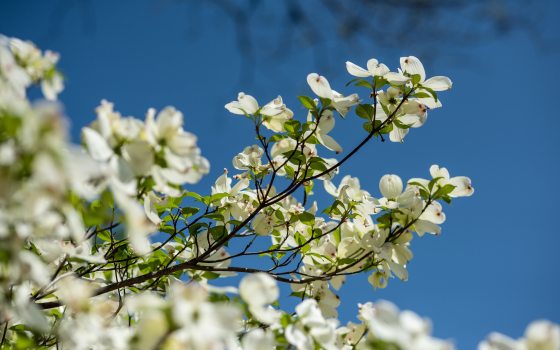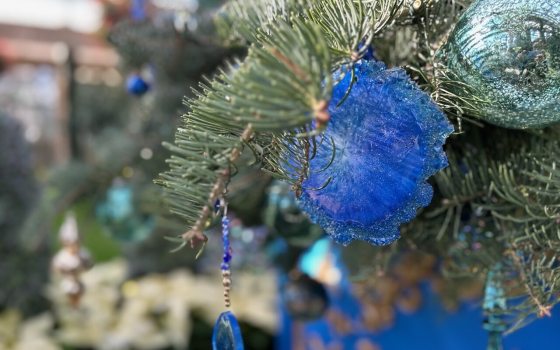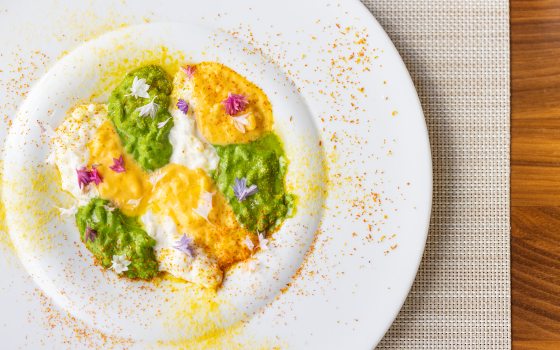While we often think of our local landscapes as self-contained, they are all part of a broader fabric of the natural world that’s as lively as it is interconnected. Where we live, work, and play is a patchwork of homes, roads, businesses, farms, forests, and waterways—and we share these spaces with thousands of species of plants and wildlife. That’s why it’s essential to surround ourselves with native plants. More than just beautiful additions to a garden, native plants are also powerful links within our living network, ones that connect wildlife with their native regions and foster biodiversity. When you plant natives in your garden, you’re creating a vibrant, resilient natural space that supports your local ecosystem for years to come. Want to learn how you could incorporate the best natives into your home garden or landscape? Read on for how to do so and where you can view native species here at Longwood … and then join us here in our Gardens on May 16 and 17 to learn even more as we celebrate Pennsylvania Native Species Day with a variety of activities.
Whether you’re planting in full sun or dappled shade, in dry soil or a rain garden, there’s a native plant that can fit beautifully into your space—and help you make your garden part of something bigger. Now, let’s get planting!
Woody Natives
Shrubs and trees are important for healthy ecosystems. Not only do they help with erosion control, carbon storage, and aesthetic design structure, they also provide food and habitats for countless species. If you’re looking for native woody plants that add color and ornamental interest to your space throughout the year, let’s take a walk through our Gardens to gather some ideas.
Starting at the entrance of our Gardens, head east and make your way to the Lakes District where you’ll spot the woody native Blackhaw viburnum (Viburnum prunifolium) near the east end of Flower Garden Walk or near Peirce’s Woods.
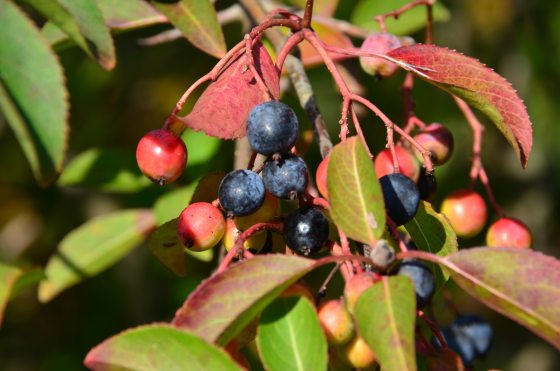
Blackhaw viburnum (Viburnum prunifolium) feature blue-black fruits that appeal to birds. Plus, it has beautiful red and purple foliage in the fall. Photo by Candie Ward.
Near the Italian Water Garden, you can find the flowering dogwood (Cornus florida). It is loved for its large and distinctive white flowers, glossy red fruits that provide winter food for birds, and deep red fall color.
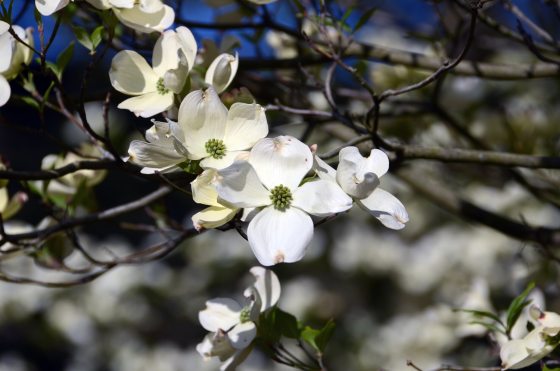
The pretty white flowers of the flowering dogwood (Cornus florida) bloom in the spring. Photo by Candie Ward.
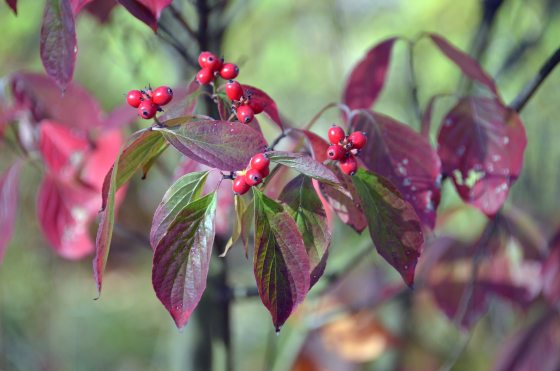
Red fruits grow from the flowering dogwood (Cornus florida) during the winter, paired with uniquely colored foliage. Photo by Candie Ward.
If you want to view a native species featuring dense foliage with bird-friendly berries, stroll to Peirce’s Woods where you’ll find several red chokeberry (Aronia arbutifolia). Similarly, black chokeberry (Aronia melanocarpa) can be spotted near the entrance of the Forest Walk. Both are excellent native choices.
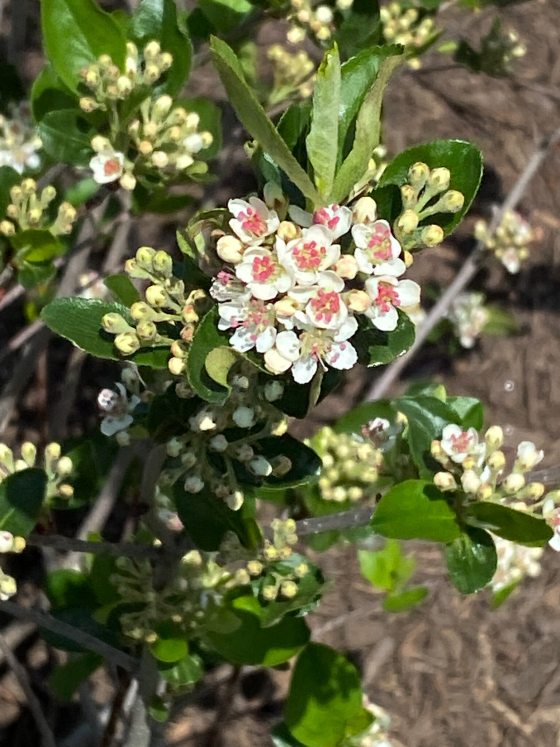
Red chokeberry (Aronia arbutifolia) is a tough plant that provides four-season interest to your garden. Photo by Candie Ward.
Entering Peirce’s Park, you’ll find redbud (Cercis canadensis), which blooms with bright pink edible flowers in early spring, followed by heart-shaped leaves that turn bright yellow in fall. Drifts of redbud can also be spotted on the edges of the Meadow Garden.

A native showstopper that flowers early in spring, redbud (Cercis canadensis) is shown here in Peirce’s Woods. Photo by Amy Simon Berg.
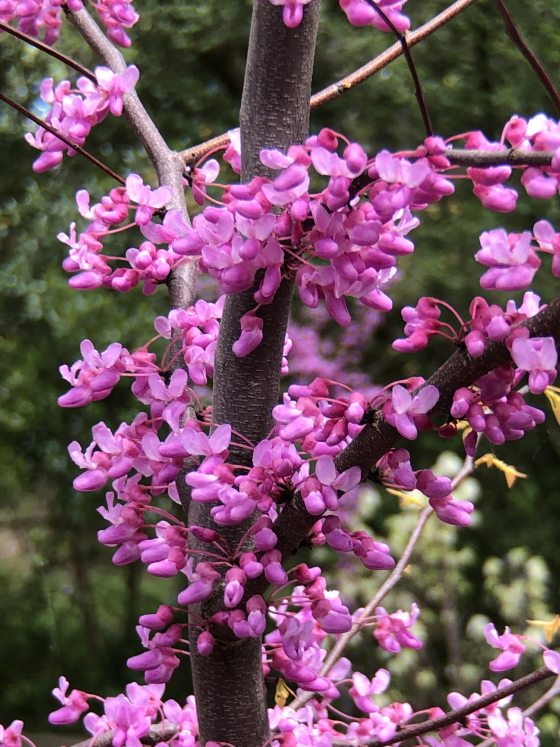
Eastern redbud (Cercis canadensis) produces its flowers directly on the stems and trunk of the tree. This unusual botanical trait is known as cauliflorus. Photo by Candie Ward.
In the Meadow Garden, you can spot silky dogwood (Cornus racemosa) along the path, with its understated cluster of blooms in late spring. If you're looking to protect and enhance sunny, moist habitats, we often use winterberry holly (Ilex verticillata) to support the ecosystem along streams and other wet areas—it's a key plant we rely on in places like our Meadow Garden. Not only does it add seasonal interest in winter with its beautiful red berries, but it also shades the water, cooling it down and improving its health.
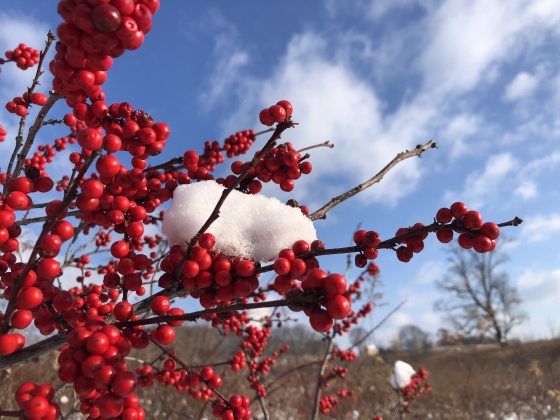
Winterberry holly (Ilex verticillata), shown here in the Meadow Garden, is a deciduous shrub with bright red berries in fall and winter. It makes any winter landscape extra cheery—especially when it snows. Photo by Lea Johnson.
Finally, make your way to the Main Fountain Garden, where you can see ninebark (Physocarpus opulifolius) in early summer, with its gorgeous exfoliating bark and cream-colored flowers. Ninebark is of special value to wildlife, as several insects including bees, butterflies, and beneficial wasps rely on it for shelter and food. Birds and mammals also eat the seeds and use the shrub for shelter.
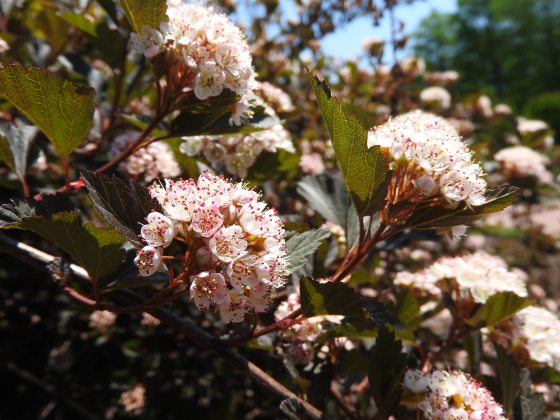
Native ninebark (Physocarpus opulifolius) is a shrub with attractive flowers. In the fall, its foliage turns a deep red. Photo by Cathy Matos.
To support native pollinators, we also plant the heart-leaved willow (Salix eriocephala). This multi-trunked tree provides an excellent habitat for caterpillars of the stunning mourning cloak butterfly.
These plants are perfect options to add interest and beneficial qualities to your garden or outdoor space.
Herbaceous Natives
Native herbaceous plants play an essential role in supporting wildlife—and, they can add lush beauty to your garden or outdoor space. Let’s take a look at where you can find these natives throughout our Gardens and discover some tips and inspiration for incorporating them into yours.
Starting at the Lakes District, you can find a native shade plant that you can get wild about—Wild Geranium (Geranium maculatum). This is a great native choice, as this spring-blooming perennial is covered in a profusion of lavender-colored flowers that attract a wide range of pollinators.
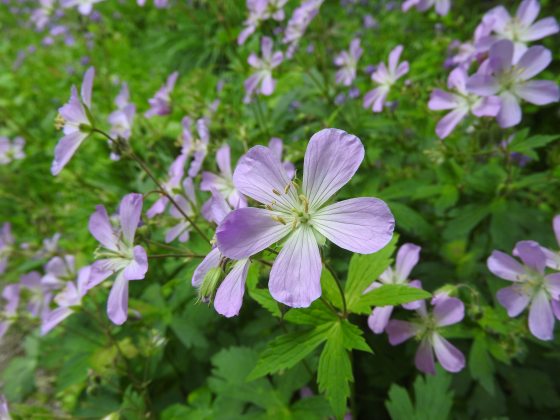
Wild Geranium (Geranium maculatum) grows 1.5 to 2 feet tall and wide, forming neat, mounded clumps. Native to woodland habitats, it prefers partial shade but will tolerate full sun in consistently moist soils. Notably, this species is resistant to deer and other browsing herbivores. Photo by Cathy Matos.
While there are countless species that thrive in sunny locations, let’s spotlight a few. Throughout the lower Meadow Garden in the summer, you can find a native pollinator favorite—and a bold one at that—the butterfly weed (Asclepias tuberosa).

A host plant for monarch butterflies, butterfly weed (Asclepias tuberosa) is a bright orange drought-tolerant plant that thrives in sun and poor soils, making it an excellent low-maintenance choice for vibrant color and ecological impact. Photo by Dee Armstrong.
Another native shade star is Wild Ginger (Asarum canadense). Found along the Forest Walk, Wild Ginger is a great groundcover for shady, moist areas, helping to suppress weeds, prevent soil erosion, and support native pollinators with its unique, hidden flowers. Its heart-shaped leaves create a lush, carpet-like effect, and although its small, reddish flowers are often hidden beneath the foliage, they are adapted to attract ground-dwelling pollinators like beetles.
Culver’s Root (Veronicastrum virginicum) is another excellent herbaceous perennial, found near the Idea Garden and Rose Garden on the west side of our Gardens, as well as in the Hourglass Pavilion near the Meadow Garden. This striking plant showcases elegant, candelabra-like clusters of tiny white flowers starting in early summer and blooming over an extended period. Its tall stature adds bold vertical interest to the landscape, while its hollow stems offer important habitat for native stem-nesting insects.

Best grown in full sun, Culver's Root (Veronicastrum virginicum) can tolerate light shade, though plants may require staking in lower light to prevent flopping. It is a strong candidate for rain gardens as it prefers moist soils but handles dry spells once established. Photo by Hank Davis.
If you’re looking to plant a native grass that offers dramatic visual display, consider Pink muhly grass (Muhlenbergia capillaris). Found around the Idea Garden, it adds showstopping late season color to a space with its clouds of delicate pink flower panicles.

Pink muhly grass (Muhlenbergia capillaris) also tolerates heat, humidity, poor soil, and salt—making it a low-maintenance star. Photo by Candie Ward.
These native plants offer more than just pretty blooms. They also anchor a sense of place, connect gardens to local ecosystems, and provide critical resources for wildlife. A good mantra to remember: the greater the diversity of type of plants you have (both in species and structure), the greater the diversity of life that you can support!
Explore our Gardens and see for yourself the natives we weave within our display throughout—to be both a beautiful place to enjoy nature and a beneficial, biodiverse haven for wildlife. We also feature a variety of natives perfect for your home garden in The Garden Shop. Discover your new favorite native species and how your planting choices can make a lasting difference in our local ecosystem.
Editor’s note: We’re proudly joining gardens across the state in recognizing the fourth annual Pennsylvania Native Species Day, which falls on May 20, 2025—but we’re celebrating on May 16 and 17 with a variety of programs focused on the importance of native species. Enjoy two days full of fascinating native species exploration; programs include guided walks through our Gardens with Longwood experts, the opportunity to meet native species-focused organizations, a look at how to build bluebird boxes, and more—all free with Gardens Admission. Available while supplies last from 4 to 7 pm each day, you can also take home either a Culver's Root (Veronicastrum virginicum) or a Butterfly-weed (Asclepias tuberosa) to grow in your home garden. Get involved and grow your passion for native plants with us—there are so many ways to do so.
